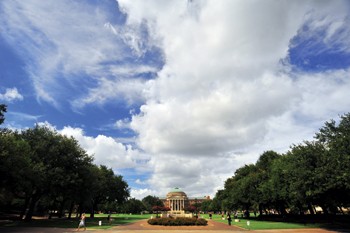
(Stuart Palley)
The invitation requested that the SMU community “meet at the Mustangs.”
Today, at 11:45 a.m., that bronze statue in front for Moody Coliseum will serve as the backdrop to the announcement of the beginning of the public phase of SMU Unbridled: The Second Century Campaign, a five-year major gifts campaign that will coincide with the centennial anniversary of the founding of SMU in 1911 and its opening in 1915.
SMU hopes to raise at least $750 million. The quiet phase of the campaign began two years ago and has already raised $317 million in commitments from 29,488 donors.
“Recognizing our first 100 years, The Second Century Campaign looks boldly to the future to build a new era of achievement,” SMU President R. Gerald Turner said. “This campaign will strengthen our ability to enable the best students to attend SMU and the most distinguished faculty to teach and inspire them through challenging academic programs.
“With these contributions to the intellectual and economic vitality of Dallas, SMU will increasingly play a leadership role in supporting our region as a national center of commerce and gateway to the global community.”
The Second Century Campaign will focus on endowments in three areas of the university: student quality, academic distinction and campus experience.
“While we will see new campaign endowments make an immediate impact, endowments are essential in providing long-term resources that grow over time and ensure economic stability,” Turner said.
SMU has an endowment of $1.4 billion and currently ranks 54th among institutions nationally.
“Because much of the endowment is targeted to specific programs, we need additional endowment funds to support new initiatives,” Turner said. “That’s what this campaign is all about.”
With the campaign, SMU hopes to attract “the ablest and most diverse students,” according to Vice President for Development and External Affairs Brad Cheves. This goal will be achieved through an expansion of scholarship programs, such as SMU President’s Scholars and Hunt Leadership Scholars.
SMU will also use the campaign to create new scholarships within different schools and disciplines, found new leadership programs, increase monetary support for graduate students and create more opportunities for students to study abroad through scholarships and additional programs.
The quiet phase of the Second Century Campaign has already brought 175 endowed scholarships; an endowed academic department, the Roy M. Huffington Department of Earth Sciences; five academic institutes, initiatives, and centers; and $20 million for a seventh school at SMU, the Annette Caldwell Simmons School of Education and Human Development.
In seeking the best and brightest, SMU has seen its SAT scores jump 97 points in the past ten years.
SMU also wants to increase the number of endowed faculty at SMU to 100, increase faculty research grants by 50 percent and endow departments and institutes. Nine endowed faculty positions have been added since the quiet phase began, bringing the total number of faculty endowments to 71.
As part of its plan to increase faculty and academic excellence, SMU also wants to expand opportunities for undergraduate research and invest in new technologies and facilities.
Seven new or renovated facilities have been announced since the start of the campaign, including the Elizabeth Perkins Prothro Hall for the Perkins School of Theology.
SMU’s last goal is to enhance the campus experience for students. This includes researching and developing a residential college or commons system as part of a sophomore residency requirement. Cheves said that a sophomore-housing requirement would “give students more of an on-campus experience.”
To do this, SMU is seeking to add residential facilities for 1,200 students to its campus.
The university is also planning to enhance its athletics program, which “teaches leadership skills and builds community spirit,” according to an SMU press release.
SMU also hopes to expand its services in health care, career placement and wellness. With the fundraising money, it will also improve its other campuses, SMU-in-Legacy and SMU-in-Taos.
Officials have already broken ground on new facilities in Taos to make the campus available year round.
“The Board of Trustees believes that SMU has all the ingredients for a major leap in academic excellence, and it’s our commitment to accelerate this momentum,” SMU Board Chair Carl Sewell, a co-chair of the campaign, said. “Our recent improvements in student quality show us that SMU increasingly attracts the best students, and we must provide scholarships that remove financial barriers for these talented young people. They will be inspired by faculty who excel at teaching and creating new knowledge, and they will benefit from a campus experience that develops leadership skills.”
Leading the campaign is the Campaign Leadership Council, a 15-person group including SMU Trustee Gerald J. Ford as the convening co-chair, and SMU Trustees Carl Sewell, Ruth Altshuler, Ray L. Hunt and Caren H. Prothro. The council guides the 39 Steering Committee Co-Chairs, which focus on different schools and disciplines in cities and regions throughout the world.
Organizers of the campaign have set up a volunteer network, which employs 327 volunteers to help with the fundraising efforts. Within this network, SMU has five major sites in the United States: Atlanta, New York, Houston, Los Angeles and Chicago. There are also two major bases in Hong Kong and Mexico City.
“What these donors will share is a conviction that supporting SMU is an investment in great human potential,” he said. “We have a solid volunteer structure that will take this campaign across the globe, and we expect broad participation among our more than 100,000 alumni.”
Cheves said alumni participation in the fundraising efforts is crucial. SMU has set a goal of having 25 percent of its alumni give each year and having 50 percent of its former students donate during the entire campaign.
The last major gift campaign, “A Time to Lead” ran from 1997 to 2002 and raised $542 million for the university. The goal was $300 million.
That campaign brought 80 endowments for academic programs, 171 student scholarships and awards, 16 academic positions, 28 campus life initiatives, and 14 new or renovated buildings.
Ford said that this campaign’s theme “reflects the bold vision of our founders as they looked at the North Texas prairie and envisioned a great university there.”
“SMU’s founders were daring, imaginative and creative, and they saw unlimited potential in what they were establishing,” he said. “We’re going to take that drive and aggressively carry it forward.”









